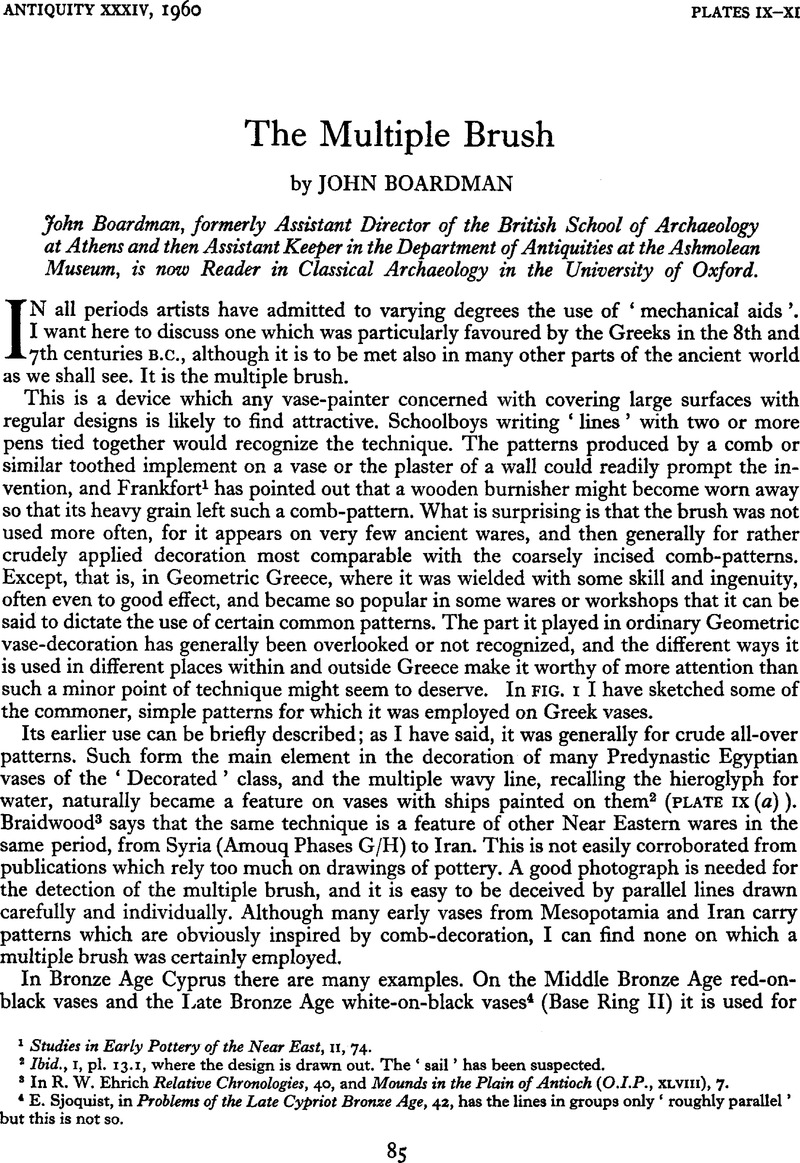Article contents
Abstract

Information
- Type
- Research Article
- Information
- Copyright
- Copyright © Antiquity Publications Ltd 1960
References
1 Studies in Early Pottery of the Near East, 11, 74.
2 Ibid., I, pl. 13.1, where the design is drawn out. The ‘sail’ has been suspected.
3 In R. W. Ehrich Relative Chronologies, 40, and Mounds in the Plain of Antioch (O.I.P., XLVIII), 7.
4 E. Sjoquist, in Problems of the Late Cypriot Bronze Age, 42, has the lines in groups only ‘roughly parallel’ but this is not so.
5 The vase quoted by Kiibler in Kerameikos, I, 141 as a Mycenaean example of the use of a compass and with multiple brush is from a Geometric grave; see Archaiologike Ephemeris, 1891, 27, pl. 3.1.
6 Good photographs in C. Zervos’ L’Art en Crète, fig. 426.
7 Cf. Palace of Minos, 1, 593. Furumark’s explanation of the technique in Mycenaean Pottery, 423 f. cannot be correct.
8 Desborough, in Protogeometric Pottery, 62, 136, 190, remarks on the use of the same multiple brush on different vases. It is not used for hatched patterns as on the vases, ibid., pls. 6 top left, 8 centre.
9 Some of the earliest examples of free-hand use seem to be on vases such as those shown in Kerameikos, V, I, pls. 30-1, 44.
10 I discuss Cypriot practice in this period in Anat. Studies, IX (1959), 166 f.
11 Ibid., 163 ff.
12 K. F. Johansen, Exochi, 155-61, figs. 223-4. The origin of the motif may lie in the free-hand hooks on ‘Cappadocian’-Hittite vases, as Frankfort, op. cit., 11, pl. 10.5
13 E. Akurgal, Phrygische Kunst, pls. 1–31, passim.
14 Cf. B.S.A., XLII, 147, fig. 6b, birds 5 at a time, a 14-membered brush for the side lines; the Analatos hydria, B.S.A., XXXV, pl. 38b, birds in 3s; ibid., pl. 42a, birds in 4s. K. F. Johansen, Les Vases Sicyoniens, pl. 17.1, for Protocorinthian birds in 4s.
15 This is one of three hydriae by the same artist who used the same multiple brush on each; B.S.A., XXXV, pls. 44-6.
16 K.P. 182; unpublished. I am indebted to Prof. J. L. Benson for a photograph and permission to mention the piece.
17 E.g. R. Hampe, Frühe griechische Sagenbilder, pls. 18-9; B.S.A., XLVII, 16 f. pls. 3-4; Thera, 11, 199-204 figs.
18 Cf. A. Akerström, Der geometrische Still in Italien, passim.
19 B.S.A., LII, 17, pl. 2c.
20 B.S.A., XLVII, pl. 3A for the Eretria vase. For the use in latest Attic Geometric see B.S.A., XLII, pls. 20-1. Here, as in other notes, I have given easily accessible examples only; they could be multiplied many times over.
- 2
- Cited by

